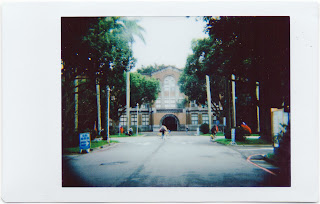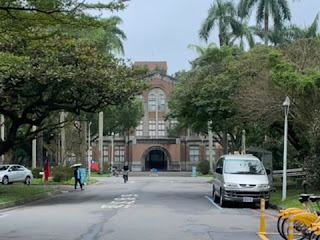This time, I tested the shutter of the NONS SL42 II camera using the Yashica Lens ML 35mm f2.8. The lens has a minimum aperture of f16, and if it could reach f22, it would be more suitable for Fujifilm Instax ISO 800 film. The NONS SL42 II is equipped with a 1.8x multiplier lens on top of the Yashica lens, so the film's ISO value will be approximately 800/1.8/1.8=247, close to 250 (based on past experience, I prefer to slightly overexpose Instax film, so I set the light meter to ISO 200). Under sunny conditions, the optimal combination would be f16 and 1/250. Since 1/250 is the maximum shutter speed of the NONS SL42 II, it's challenging to choose a larger aperture like f5.6 or f8 to capture a well-focused subject with a blurred background in bright sunlight.
這次來測試NONS SL42 II相機的快門,使用的鏡頭是Yashica Lens ML 35mm f2.8,最小光圈是f16,如果可達f22將更適合Fujifilm Instax ISO 800的底片。由於NONS SL42 II還會再裝上一個1.8倍鏡,再接上Yashica鏡頭,所以底片的 ISO值將會相當於 800/1.8/1.8=247 接近 250 (依過去使用經驗,我習慣讓Instax底片多曝光一點,所以測光表我設訂成ISO 200)。如過在拍照的Sunny rule下,會是f16和1/250的組合,1/250已經是NONS SL42 II這相機的最高速快門了,所以想要選擇較大光圈如f5.6、f8來拍點主體清楚且背景模糊的相片,在大太陽底下幾乎不可能。
The first set of test shots was taken under a tree shade, creating a somewhat overcast feeling, approximately 3 stops lower than f16, resulting in the combination of f5.6 and 1/250. Under the same EV value, subsequent photos were taken with the combinations of f8 and 1/125, f11 and 1/60, and f16 and 1/30, respectively. Upon closer inspection, except for the fourth photo, the central area of the other photos shows slight overexposure, suggesting that the shutter speed scaling in the center might be slower. The fourth photo itself is clearly underexposed, and my guess is that the lens might have over-closed at f16, requiring a compensation of 0.5-1 stop.
第一組測試點是在樹蔭下,大概是陰天的感覺,比f16低3級,也就是f5.6與1/250的組合,再相同EV值下依序拍得f8與1/125、f11與1/60、f16與1/30組合的相片。仔細看除了第4張相片,其他相片的中央,都有些許過度曝光,推測這快門的縮放在中央的速度可能較慢。而第4張相片本身也很明顯曝光不足,我的推測是鏡頭在f16光圈可能縮過頭了,可能要補償0.5-1級才行。
First Set - No ND4 Neutral Density Filter
第一組 無ND4減光鏡
#1. f5.6 1/250
#2. f8 1/125
#3. f11 1/60
#4. f16 1/30
The second set of test shots captured the exterior of a building with reflective beige tiles. The metering result should have been adjusted by an additional 1 stop of exposure, but I overlooked this while focusing on the installation of the ND4 neutral density filter. The light meter's ISO value needed to be adjusted to 50 when using the ND4 filter. It can be observed that, under slight underexposure conditions, only the central point (windows) of the fifth photo shows a slight white overexposure. Similarly, the eighth photo with f16 shows underexposure.
第二組測試點拍攝的建築物外觀是會「反光」的土黃色磁磚,測光的結果應該要再加1級曝光,但拍攝當下我忽略了,只專注於鏡頭加裝ND4減光濾鏡後須將測光表的ISO值調整為50。可以觀察到,再曝光較為不足的情況下,只有第5張相片的中心點(窗戶處)有些許泛白的過曝。同樣的第8張f16曝光不足。
Second Set - No ND4 Neutral Density Filter
第二組 無ND4減光鏡
#5. f5.6 1/250
#6. f8 1/125
#7. f11 1/60
#8. f16 1/30
The third set of test shots was taken under a tree shade, capturing backlit leaves. Due to a large area of overexposed sky in the frame, the overexposure in the central area of the photo becomes apparent, especially when the overexposed sky area is larger (as seen in the tenth photo), resulting in overexposure above the tree shade.
第三組測試點是在樹蔭下拍攝背光的樹葉,由於畫面中有較大面積的過度曝光天空,相片中央的過度曝光區域變得很明顯,當過度曝光天空面積更大時(如第10張相片),樹蔭上方也出現過度曝光的現象。
Third Set - No ND4 Neutral Density Filter
第三組 無ND4減光鏡
#9. f5.6 1/60
#10. f8 1/30
Based on the above tests, it is speculated that when there is a large area of overexposure in the photo, it leads to overexposure in the central area and even other sections of the image. This issue persists even at slow shutter speeds of 1/30 and 1/60.
經過以上測試,推測當相片畫面中有較大面積的過度曝光區域時,就會造成畫面中心,甚至其他區塊的過曝,即使是在慢速快門1/30、1/60下仍是無法避免。












